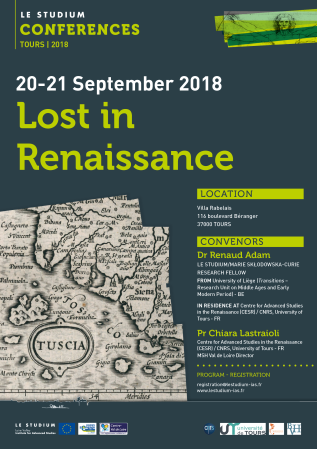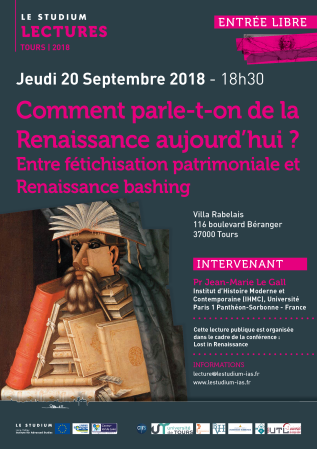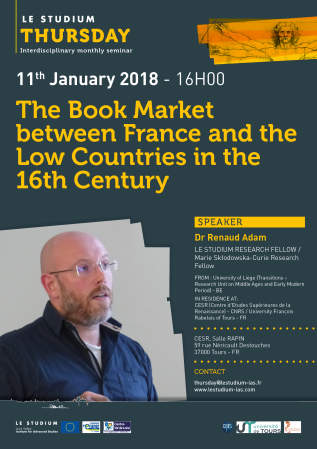Dr Renaud Adam

From
University of Liège (Transitions – Research Unit on Middle Ages and Early Modern Period) - BE
In residence at
Centre for Advanced Studies in the Renaissance (CESR) / CNRS, University of Tours - FR
Host scientist
Prof. Chiara Lastraioli
PROJECT
Bibliopol@: The book market in the renaissance between France and the low countries
The invention of the printing press by Gutenberg in the mid-fifteenth century is one of the most important technical advances in history. It had a profound impact on European civilization and gave birth to the first great “media revolution”. The immediate effect was to multiply the amount of books in circulation and to reduce their cost. The Gutenberg revolution carried the European book market to a new level. Booksellers had to deal with multiple hundreds of copies, not rather than in single copies as at the manuscript age. The name of Gutenberg would not have been associated with the invention of western modernity without the action of these bookmen.
Until now, researches on the early history of printed books have been mainly focused on the world of printers, the production of books and on lectors and their reading practices. The intermediate level of the book industry has remained more or less neglected. However, some recent works have highlighted the fact that the engine and the frame of the Gutenberg revolution lied precisely in the structures and the evolution of book diffusion.
The aim of the project is to investigate this very aspect of the first media revolution. It will focus on the trade relations between France and the Low Countries which have never been the subject of systematic analysis. The study of the book market is not only a chapter of economic history; it is also an accurate point of view to think about the most fundamental cultural trajectories. As a consequence, the ambition of this project is to renew our knowledge of cultural exchanges between France and the Low Countries through the study of the circulation of books between these two territories as well as through the reconstruction of networks and legal framework for the sale of books. The expected result is to shed new light on the underlying factors which would explain the passage from the Middle Ages to Modernity of these two countries and their influence on each other in this process.
Publications
Bruxelles et le livre: regards sur cinq siècles d'histoire (XVIe-XXe siècle)
Lorsque l’on évoque le phénomène de la contrefaçon sous l’Ancien Régime, les historiens du livre se montrent parfois hésitants sur l’acceptation qu’il convient de lui donner : faut-il le limiter à l’aspect strictement juridique ou doit-on plutôt l’étendre au domaine éthique ? Ils s’entendent toutefois sur le préjudice porté à l’auteur, au créateur ou encore au producteur victime de la contrefaçon. De notre point de vue, et même s’il n’est pas toujours aisé de saisir pleinement les contours de cette notion, nous réconcilierions volontiers les deux acceptations en employant les formules suivantes : la « contrefaçon stricto sensu » qui renvoie à l’aspect purement juridique et la « contrefaçon lato sensu » qui élargit le concept à l’imitation frauduleuse d’un ouvrage (page de titre, adresse bibliographique, mise en page…).
À partir des années 1565-1566, les anciens Pays-Bas furent secoués par une vaste contestation politico-religieuse dirigée contre Philippe II. Pour réprimer cette agitation, le souverain mit en place un tribunal d’exception, le Conseil des troubles, et le plaça sous l’autorité directe de Fernando Alvarez de Tolède, duc d’Albe et gouverneur général des Pays-Bas. Cette institution, active de 1567 à 1576, surveilla de très près la fabrication, la vente et la possession de livres, en raison du danger potentiel de ce véhicule culturel qu’est l’imprimé. Ainsi, à la requête du duc d’Albe, des inquisiteurs furent envoyés en 1569 dans différentes provinces des Pays-Bas espagnols afin d’examiner les fonds des libraires et des imprimeurs et de dépister les livres hérétiques. Ces documents offrent un instantané inédit des livres en circulation dans de nombreuses villes de ce territoire. Je me penche uniquement sur la situation de la ville de Mons. L’inventaire exécuté par les envoyés du duc d’Albe décrit un peu plus de 1600 livres. Ce document précise non seulement le nom des auteurs et les titres, mais aussi les adresses bibliographiques des ouvrages listés. Le soin et la rigueur dont a fait preuve le notaire dans l’exécution de sa tâche font de cette source un document de premier ordre pour l’étude du marché du livre en Hainaut dans le second tiers du XVIe siècle en général et, plus particulièrement, pour le livre médical. On pourra notamment découvrir quels sont les auteurs et les genres les plus prisés, le poids de la littérature savante par rapport à celle de vulgarisation ainsi que l’origine géographique de ces livres.
Avec pas moins de quelque six cents éditions relevat de corpus galénique recensés au XVIe siècle, il apparaît sans contredit que le modèle médical dominant à la Renaissance reste toujours bel et bien celui de Galien et de sa théorie des humeurs. La plus ancienne édition latine remonte au 27 août 1490 et est sortie des presses vénitiennes de Philippus Pincius (ou Pintius). Il s'agit de la première impression des oeuvres complètes du maître de Pergame, éditées en latin par le médecin de Brescia Diomède Bonardus et reproduites en deux volumes imposants au format in-folio. Le premier tome compte 224 feuilles, le second 248 ; soit un volume total de 236 feuilles de papier pour imprimer un seul exemplaire. Le corpus galénique a été classé par l'éditeur selon des critères thématiques et de difficultés de lecture. Une vingtaine d'autres Opera omnia verront le jour au cours du XVIe siècle (dont deux en grec), imprimées presque exclusivement à Venise. Le classement établi par Johannes Baptista Montanus pour celles parues en 1541 chez les Giunta servira de modèle pour les éditions ultérieures. Il repose sur cinq critères : thématique, difficulté de lecture, authenticité, genre littéraire et matériel.
The starting point for this paper are the archives produced by the so-called Council of Troubles, the special court established by Philip II in response to the uprising and misbehaviour of parts of the population of the Low Countries in the years 1566–1567. This institution remained active from 1567 to 1576 and was commanded by the Duke of Alva. In particular, being well aware of the potential of those cultural objects and carriers of ideas, it watched very closely the production, the distribution as well as the possession of books. The documents contain inventories of thousands of books – either forbidden or not – found in bookshops located in the southern provinces. I will focus my paper on the 12 bookshops located in Brussels visited in 1568 by religious authorities, and especially in that of Michiel van Hamont, printer from 1557 to 1585. The repressive measures taken by the Duke of Alva will be the entry point of a study on the state of book culture in Brussels during the last third of the sixteenth century.
Final reports
The aim of our project was to investigate on the book trade during the Renaissance. It had focused on the relations between France and the Low Countries which have never been the subject of systematic analysis. The study of the book market is not only a chapter of economic history; it is also an accurate point of view to think about the most fundamental cultural trajectories. As a consequence, the ambition of this project was to renew our knowledge of cultural exchanges between France and the Low Countries through the study of the circulation of books between these two territories.



